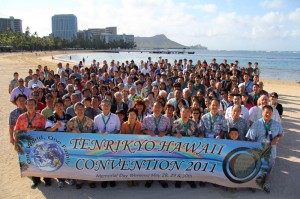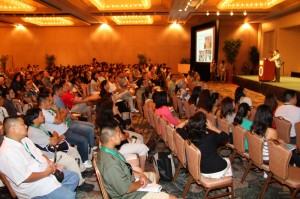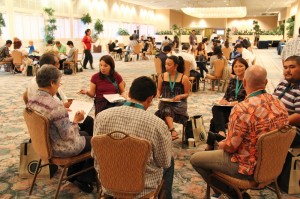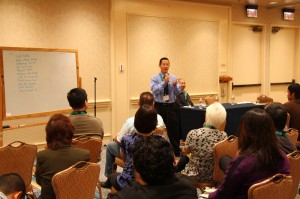 Tenrikyo Hawaii Convention 2011 was held in Honolulu between May 28 and 30. The event was hosted by Tenrikyo Mission Headquarters of Hawaii, which had backup support from Tenrikyo Overseas Department. It served as a catalyst for English-speaking followers to meet in one location, strengthen their connections to the faith, and explore new frontiers for the world mission. The convention program included a “Study of the Service,” five elective courses, and talks from guest speakers, including a Motivational Address from Rev. Masahiko Iburi. The convention was attended by 320 participants from seven countries. Members of the upcoming generation particularly stood out as participants engaged in fervent discussions on how they implement the faith in daily life.
Tenrikyo Hawaii Convention 2011 was held in Honolulu between May 28 and 30. The event was hosted by Tenrikyo Mission Headquarters of Hawaii, which had backup support from Tenrikyo Overseas Department. It served as a catalyst for English-speaking followers to meet in one location, strengthen their connections to the faith, and explore new frontiers for the world mission. The convention program included a “Study of the Service,” five elective courses, and talks from guest speakers, including a Motivational Address from Rev. Masahiko Iburi. The convention was attended by 320 participants from seven countries. Members of the upcoming generation particularly stood out as participants engaged in fervent discussions on how they implement the faith in daily life.
Over 60 percent of convention participants were from the state of Hawaii. In addition, followers from Australia, Canada, France, Hong Kong, Japan, the U.K., and the mainland U.S. also attended the event. While most age groups were represented, the majority of participants were in their 30s, followed by the 20s and 40s age brackets.
Ms. Helen Orikasa, a Yoboku from Maui, expressed how promising it was to see so many young people attending the event. She also said she looked forward to talking to fellow followers from other islands that she does not usually get to see.
Nurturing the Next Generation of the Path in Hawaii
The convention was mainly planned and run by younger followers from Hawaii. To give some background that led to this, in 2006, the year of the 120th Anniversary of Oyasama, Rev. Iburi was appointed to his fourth term as Director-in-Chief of Administrative Affairs. In a policy speech that year, he expressed the desire to earnestly support and nurture leaders in each region in preparation for the 130th Anniversary of Oyasama. One of the measures he chose to emphasize was re-evaluating the state of the overseas mission.
Within the Hawaii diocese at the time, some were voicing the need to revitalize the mission within the diocese and nurture the next generation. The path in Hawaii began with the efforts of missionaries from Japan in the early 20th century who steadily spread the faith in the Japanese immigrant community. However, with the passing of the generations, fewer young people chose to continue the faith of their parents and grandparents.
In 2007, a “Committee for the Future Path of Hawaii” was inaugurated at the Administrative Affairs Department with the aim of developing human resources as well as reviving the Tenrikyo mission within the diocese. Also, a few months prior to this, deliberations regarding a follow-up to Tenri Forum 2006: New Frontiers in the Mission, an event that had been targeted at English-speaking followers throughout the world, also began in Jiba. Eventually, these two movements came together, which helped choose Honolulu as the venue of the next large-scale English speakers’ gathering.
At the Mission Headquarters of Hawaii, a Convention Steering Committee primarily comprised of the younger generation was formed after the prospect of holding the convention was proposed from Jiba. Looking back on this development, Bishop Michihito Hamada said: “I believed it was a good opportunity to nurture human resources. Preparations were made as we placed emphasis on the autonomy of our younger members.”
Three years prior to the event, the committee began meeting regularly to discuss the content of the convention program. Further, committee members worked proactively to invite fellow Oyasato Seminar alumni, among others, from the U.S. mainland to participate.
Head Minister Melvin Iwata of Honolulu-ko Church, who acted as an advisor to the committee, mentioned that as committee members spread the word about the convention, there emerged a few cases of people who came back to their affiliated churches after having drifted away. He also expressed his hope that the convention would help nurture the next generation of Tenrikyo followers.
An Opportunity to Contemplate and Discuss One’s Faith
The theme of the convention program was “Enriching Our Relationships with Joyous Faith.” On the first day of the convention, there was a series of regional updates from Hawaii, Australia, the U.K., New York, and Kenya. This was followed by a Joy of Life Workshop, where participants were split into small groups. After lunch, there was a “Study of the Service.” After a short video on the subject, Head Minister Colin Saito of Honolulu Church gave a well-received talk entitled “The Importance of the Service” in which he shared some of his recent insights into the meaning of some of the hand movements of the service dance. This was followed by the first public presentation of the tentative English Singable Danceable Mikagura-uta (SDM), which was a performance of the seated service and of the Eight Verses of the Yorozuyo with the singing conducted in English to the accompaniment of four musical instruments.
Head Minister Marlon Okazaki of Southern Pacific Church in Los Angeles then took the podium to present the history of the English SDM. Rev. Okazaki noted how the project had its initial start over 15 years ago. He explained the time-consuming process that involved translation committee members from both the mainland U.S. and Hawaii meeting and discussing to decide on the English words that best matched the meaning of the original Japanese Mikagura-uta text and corresponding hand movements.
After this, all participants were given the opportunity to experience the SDM version of the seated service themselves. Participants then reassembled into their groups and were given time to discuss what they had just heard, seen, and experienced.
 On the morning of the second day, there were two talks from two keynote speakers. The first was delivered by social counselor Michael DeMattos, who teaches at the University of Hawaii at Manoa. While Mr. DeMattos was someone without a Tenrikyo background, his presentation covered how faith shapes our values and strengthens our relationships. He effectively mixed his talk with group exercises to inspire participants to think and learn from one another.
On the morning of the second day, there were two talks from two keynote speakers. The first was delivered by social counselor Michael DeMattos, who teaches at the University of Hawaii at Manoa. While Mr. DeMattos was someone without a Tenrikyo background, his presentation covered how faith shapes our values and strengthens our relationships. He effectively mixed his talk with group exercises to inspire participants to think and learn from one another.
The second keynote speaker was Hajime Turner, who grew up while being simultaneously exposed to the African-Methodist church and Tenrikyo. He focused his presentation on how followers can deepen their connection to the faith and God the Parent.
Elective courses were held in the early afternoon. Among the electives were “Modern Day Yoboku” and “Nurturing Our Families through Faith.” The electives covered contemporary themes and gave participants opportunities to engage in lively exchanges of opinions.
 In the elective “Modern Day Yoboku,” participants were divided into groups of six to eight people and began discussing the ways the path touched their daily lives. One of the groups talked about the subject of sprinkling the fragrance to close acquaintances. One young man said, “When I tell people about the path, people respond that our teachings share commonalities with Christianity and I get stuck on what to say next.” A young lady then remarked on the importance of having a strong conviction in one’s faith in such circumstances.
In the elective “Modern Day Yoboku,” participants were divided into groups of six to eight people and began discussing the ways the path touched their daily lives. One of the groups talked about the subject of sprinkling the fragrance to close acquaintances. One young man said, “When I tell people about the path, people respond that our teachings share commonalities with Christianity and I get stuck on what to say next.” A young lady then remarked on the importance of having a strong conviction in one’s faith in such circumstances.
 In the elective “Nurturing Our Families through Faith,” participants reevaluated their family relationships. One young woman mentioned that there was a time when she was caught between the faith of her mother and that of her father. A young man said that he was uncomfortable about the Japanese style in which churches were run but chose to follow in his parents’ footsteps upon seeing how fervently they devoted themselves to the path.
In the elective “Nurturing Our Families through Faith,” participants reevaluated their family relationships. One young woman mentioned that there was a time when she was caught between the faith of her mother and that of her father. A young man said that he was uncomfortable about the Japanese style in which churches were run but chose to follow in his parents’ footsteps upon seeing how fervently they devoted themselves to the path.
Relationships Transcending All Generations
Truth be told, there was another convention in Hawaii 37 years ago that was targeted at the next generation. A few people who participated in the Tenrikyo Hawaii Young Men’s Convention in August 1974 were also present at this convention as well. Guest speaker Rev. Iburi happened to be the chairman of Tenrikyo Young Men’s Association Headquarters at the time.
In his Motivational Address that concluded the second day, Rev. Iburi said that he was moved to see many young native English-speakers in attendance. Noting that this indicated a steady growth in the number of young English-speaking followers who were thinking seriously about world salvation, he encouraged those listening to connect in a unity of mind, continue to move forward with the same goal in mind, and promise to meet again in the year of the 130th Anniversary of Oyasama for the next event.
Mr. Kyle Kawasaki, chair of the Convention Steering Committee, said that the convention provided many seeds for the future and emphasized the importance of what comes next. He exuded optimism that younger members will become the flag-bearers for the congregation by helping strengthen relationships that transcend all generations and revitalize missionary activities in Hawaii. Finally, he conveyed his hope to transmit the joy of faith acquired through this effort to upcoming generations.




